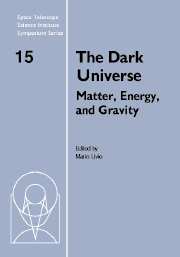Book contents
- Frontmatter
- Contents
- Participants
- Preface
- A brief history of dark matter
- Microlensing towards the Magellanic Clouds: Nature of the lenses and implications on dark matter
- Searching for the Galactic dark matter
- Hot gas in clusters of galaxies and ΩM
- Tracking the baryon density from the Big Bang to the present
- Modified Newtonian Dynamics and its implications
- Cosmological parameters and quintessence from radio galaxies
- The mass density of the Universe
- Growth of structure in the Universe
- Cosmological implications of the most distant supernova (known)
- Dynamical probes of the Halo Mass Function
- Detection of gravitational waves from inflation
- Cosmological constant problems and their solutions
- Dark matter and dark energy: A physicist's perspective
Tracking the baryon density from the Big Bang to the present
Published online by Cambridge University Press: 21 August 2009
- Frontmatter
- Contents
- Participants
- Preface
- A brief history of dark matter
- Microlensing towards the Magellanic Clouds: Nature of the lenses and implications on dark matter
- Searching for the Galactic dark matter
- Hot gas in clusters of galaxies and ΩM
- Tracking the baryon density from the Big Bang to the present
- Modified Newtonian Dynamics and its implications
- Cosmological parameters and quintessence from radio galaxies
- The mass density of the Universe
- Growth of structure in the Universe
- Cosmological implications of the most distant supernova (known)
- Dynamical probes of the Halo Mass Function
- Detection of gravitational waves from inflation
- Cosmological constant problems and their solutions
- Dark matter and dark energy: A physicist's perspective
Summary
The primordial abundances of deuterium, helium, and lithium probe the baryon density of the universe only a few minutes after the Big Bang. Of these relics from the early universe, deuterium is the baryometer of choice. After reviewing the current observational status (a moving target!), the BBN baryon density is derived and compared to independent estimates of the baryon density several hundred thousand years after the Big Bang (as inferred from CMB observations) and at present, more than 10 billion years later. The excellent agreement among these values represents an impressive confirmation of the standard model of cosmology, justifying—indeed, demanding—more detailed quantitative scrutiny. To this end, the corresponding BBN-predicted abundances of helium and lithium are compared with observations to further test and constrain the standard, hot, big bang cosmological model.
Introduction
As progress is made towards a new, precision era of cosmology, redundancy will play an increasingly important role. As cosmology is an observational science, it will be crucial to avail ourselves of multiple, independent tests of, and constraints on, competing cosmological models and their parameters. Furthermore, such redundancy may provide the only window on systematic errors which can impede our progress or send us off in unprofitable directions.
- Type
- Chapter
- Information
- The Dark UniverseMatter, Energy and Gravity, pp. 46 - 61Publisher: Cambridge University PressPrint publication year: 2004

